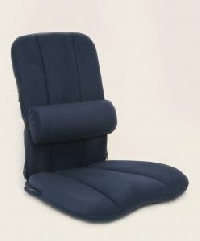
Learn how to help back pain while driving so it doesn’t ruin your road trip
Some people can drive forever without suffering any back or neck pain but there are those who start having back issues within an hour of driving. Knowing how to help back pain while driving includes a number of things, particularly the use of a lumbar or seat wedge.
Try using a lumbar support in the car. This lessens pressure on the spinal discs and relieves discomfort in the lower back. Lumbar support enhances proper posture because it is ergonomically designed. You can get a half roll lumbar support, a larger half roll or hanging lumbar, which hangs over the back of your car seat.
Contoured lumbar supports are available (and tremendously helpful) as are deluxe back care systems for those who have put long trips on hold because of their aching backs.
A seat wedge is made to relieve and prevent lower back distress while seated for a long time, whether in a car or at work. It consists of a tapered angle which prompts good posture when sitting. The wedge comes in various sizes and sacro versions with the tailbone cut-out, reducing spinal pressure. The wedges are washable as well as durable. You will get a lot of mileage out of this product and your back will thank you.
~
A contoured lumbar support provides all the perks that regular lumbar supports do but it is contoured and hugs the back of the seat.
A deluxe back care system is recommended by chiropractors, physiotherapists and doctors because it promotes comfortable yet anatomically correct sitting for the driver or passenger in a vehicle.
If you sit for long periods of time, whether in a vehicle or at a desk, this leads to back strain, aches and fatigue. This can be prevented if you are supported properly while seated.
Applying heat to your back while driving, or any time for that matter, relieves pain. Use a ‘hottie’ water bottle. Put it behind your back. It does not require hot water and you do not have to empty or refill it. This is an easy and convenient way to provide warmth and relief to an aching back.
You can also lessen and prevent back aches and soreness by taking regular breaks from driving. Stop, get out, stretch and walk around. When you drive for too long, the lumbar curve (in the back) is essentially lost. When this happens, there is strain on the discs and vertebra. In addition, the spine is jostled and vibrated when driving or riding in a vehicle and this can irritate the back.
Make sure …
…. your seat in the vehicle is adjusted to accommodate you and not the previous driver. You should sit close to the wheel but not too close. Your knees should be situated slightly higher than your hips when driving.
As you drive, remember to regularly stretch your legs, toes, feet, hands, shoulder and neck.
Do not put a death grip on the steering wheel. This leads to tension in your back. Loosen up your grip and vary it now and then.
Put your hands in the 3 o’clock and 7 o’clock positions on the wheel. After a while, change them to the 10 o’clock and 2 o’clock positions.
Some car interiors aren’t very big and they may have low roof lines. This means the car seat is also situated lower and tipped back. This results in the driver having straighter legs, which puts stress on the hamstrings, which pulls on the pelvic attachment. This position prompts the pelvis to roll backward.
Long haul driving can also cause neck soreness because of the tipped back positioning of the seat. The operator has to flex his neck up to 20 degrees just to see ahead.
Make a point of sitting properly when driving. Do not sit too far away from the pedal because this stresses the neck and upper back. Most of the thigh should be on the seat and supported by it.
In some cars, the steering wheel is a tad offset from the middle of the seat, which means the driver has to hold onto the wheel at an angle to his body. This puts pressure on his shoulders and neck.
To determine if your seat is in the proper position, place the palms of your hands together, elbows bent. Your wrists should make contact with your chest. Your fingers are pointing to the steering wheel at a right angle to the spine. You can tell if the wheel is offset if your fingers are not aiming at the center of the wheel.
